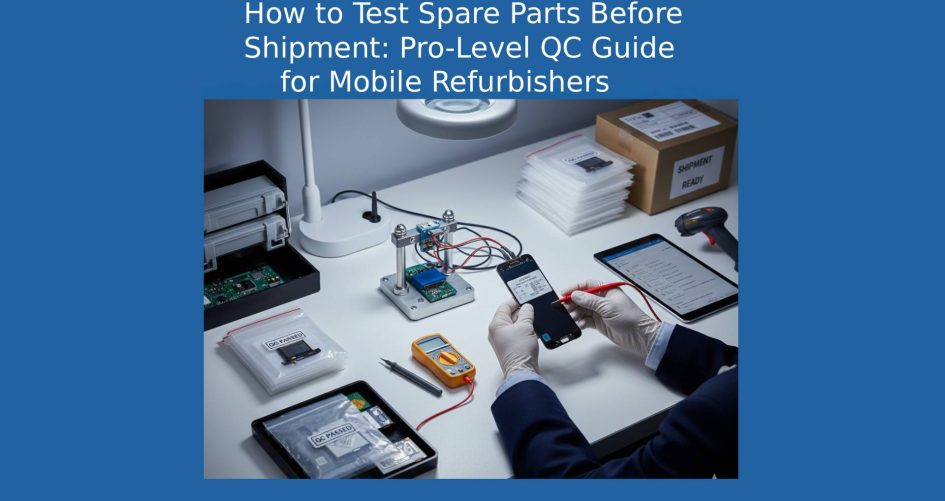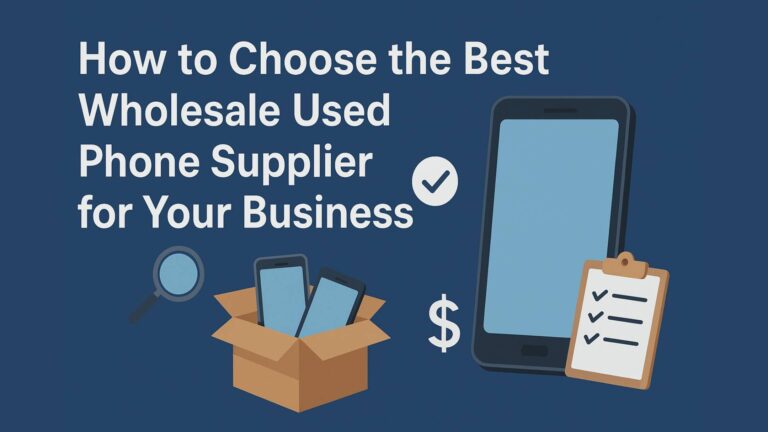In the booming refurbished mobile industry, phone part testing, performing accurate QC before export, and conducting a thorough refurbished component test are no longer optional—they’re critical. Whether you’re dealing with LCDs, batteries, cameras, or charging ports, a single faulty part can hurt your reputation and your bottom line. In this comprehensive guide, we’ll walk you through how to develop a high-efficiency testing workflow that keeps your spare parts business trusted and competitive. Know more.
Why Pre-Shipment Testing is Critical in the Mobile Spare Parts Industry
The Growing Demand for Quality Assurance
Global demand for mobile spare parts continues to grow as phone repair and refurbishing becomes more mainstream. However, buyers expect premium performance—especially from refurbished parts. That’s why phone part testing must be standardized before exporting.
What Happens Without Proper Testing
Without rigorous QC before export, you risk:
- High return rates
- Poor customer feedback
- Brand damage
- Potential losses on bulk orders
Testing isn’t just a precaution; it’s a competitive advantage.
Understanding the Basics of Phone Part Testing
What is Phone Part Testing?
Phone part testing involves verifying the physical and functional quality of each mobile spare part before shipping it to a buyer. It includes:
- Cosmetic grading
- Functionality checks
- Compatibility validation
- Performance simulation
Key Components that Must Always Be Tested
| Component | Test Type |
| LCD Screens | Color uniformity, touch response |
| Batteries | Charge retention, voltage output |
| Speakers & Mics | Audio clarity, volume consistency |
| Cameras | Focus, flash, resolution |
| Charging Ports | Charging speed, connection stability |
Setting Up an Effective QC Before Export Process
Creating a Standard Operating Procedure (SOP)
Every refurbishing operation should start with a clear SOP that outlines:
- What to test
- How to test it
- Who performs the test
- How results are recorded
Establishing a QC Team and Testing Lab
Build a skilled testing team with experience in diagnostics and repair. Equip your lab with tools specifically designed for refurbished component test procedures.
Ideal Environment for Accurate Testing
- Dust-free, ESD-safe areas
- Controlled lighting for visual inspections
- Quiet spaces for testing sound components
Stages of Refurbished Component Test Protocols
Functional Testing
Run component-level tests to ensure each part performs as expected.
Cosmetic Inspection
Assess visible wear, scratches, and discoloration using light boxes or magnification tools.
Compatibility Checks
Parts must work flawlessly on original hardware. Cross-test on multiple models if needed.
Batch Sampling vs 100% Testing
For large shipments, batch sampling may be efficient, but for high-value orders, 100% testing is best.
Phone Part Testing: Must-Have Tools & Equipment
LCD & Display Test Boxes
These simulate a live phone environment to test screen color, touch sensitivity, and dead pixels.
Battery and Charging Port Testers
Test current, voltage, and heat signatures under load to detect early battery failure.
Signal and Network Simulators
Check antennas, Wi-Fi modules, and SIM card slots for connectivity and performance accuracy.
Creating a Checklist for QC Before Export
Example of a Daily QC Checklist
✅ Screen – No dead pixels
✅ Battery – 90%+ health
✅ Speaker – Clear at all levels
✅ Mic – Picks up audio cleanly
✅ Vibration Motor – No stutter
How to Customize Checklists for Different Parts
Every spare part should have its own checklist format. Use codes (A, B, C grades) for clarity.
Common Mistakes in Phone Part Testing and How to Avoid Them
Rushing Through Tests
Speed kills quality. Always allow enough time for a full refurbished component test.
Ignoring Environmental Conditions
Humidity, dust, and ESD can skew testing results. Always maintain optimal lab settings.
Inconsistent Tester Training
Periodic refresher training ensures your QC before export remains consistent and effective.
How to Conduct a Reliable Refurbished Component Test
Testing Screens and Touch Panels
- Use display boxes with adjustable brightness
- Test for touch lag and pressure sensitivity
Testing Batteries and Charging Modules
- Use amp-meters and USB testers
- Check for abnormal heat or drain
Testing Cameras, Speakers, and Vibration Modules
- Use reference audio clips
- Capture images under various lighting
- Ensure haptic feedback is uniform
Packaging and Labelling After QC Before Export
Labeling Parts According to Grade and Functionality
Use clear grading:
- A+ – Like New
- A – Minor signs of use
- B – Visible but non-functional wear
Safe Packaging Guidelines to Prevent Transit Damage
- Use anti-static foam
- Seal each part in anti-moisture pouches
- Box with dividers and buffer layers
Digital Documentation and Reporting for Better Traceability
Creating Digital QC Reports
Digital records make audits and returns faster. Include:
- Inspector ID
- Date/time of test
- Test results per function
Linking Test Results to Serial Numbers or Barcodes
This adds a digital trail for every part sold—useful for both buyers and internal accountability.
Compliance & International Standards for Exporting Mobile Parts
ISO Standards in Electronics QC
Adopting ISO 9001 or 14001 can boost buyer confidence and open new markets.
CE, RoHS, and Other Labels Explained
- CE – EU safety standard
- RoHS – Restricts hazardous materials
- FCC – Required for US electronics
Why Phone Part Testing Builds Long-Term Buyer Trust
Lower Return Rates and Higher Buyer Satisfaction
Well-tested parts reduce disputes and build strong, long-term relationships with buyers.
Case Study: Refurb Company Boosting Profits via Testing
One refurbished wholesaler cut their returns by 60% after introducing triple-layer phone part testing—resulting in higher repeat orders.
FAQs: QC and Testing of Mobile Spare Parts
1. How often should I update my QC procedure?
Every 3-6 months or when dealing with a new model line.
2. Is it okay to batch test spare parts?
Only for low-cost or low-risk parts. For core components like displays or batteries, test each one.
3. Can I automate any part of the refurbished component test?
Yes, software diagnostics can automate display, camera, and battery tests.
4. What’s the best way to ensure QC before export is followed every time?
Implement digital checklists with QR-based sign-offs.
5. What certifications can help boost my testing credibility?
ISO, CE, and RoHS certifications improve trust in your process.
6. How do I test refurbished parts for compatibility?
Cross-test parts on at least two model variants, especially for Samsung and iPhone components.
Conclusion: Building a Strong Testing Workflow for Export Success
Ensuring a consistent, thorough process for phone part testing, following strict QC before export, and using advanced refurbished component test protocols will elevate your brand and protect your profits. From testing to packaging, every step adds value—earning trust, increasing orders, and reducing costly returns.
If you’re in the refurbished mobile wholesale business, this isn’t just best practice—it’s the gold standard. Know more.





